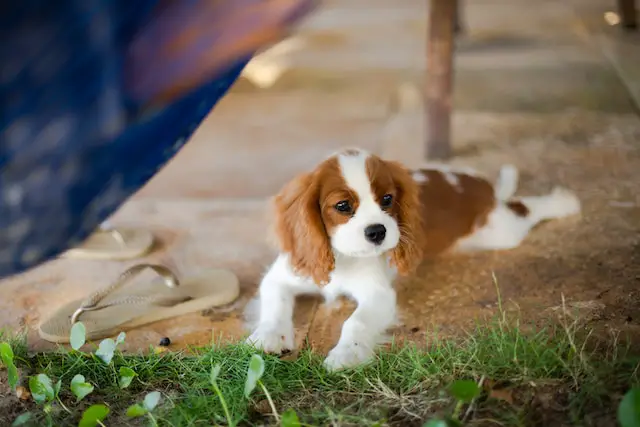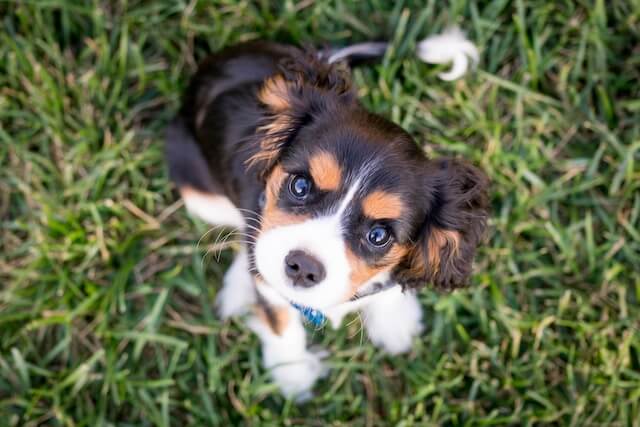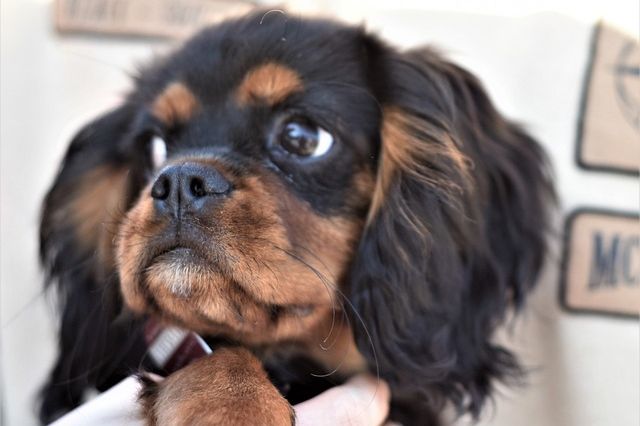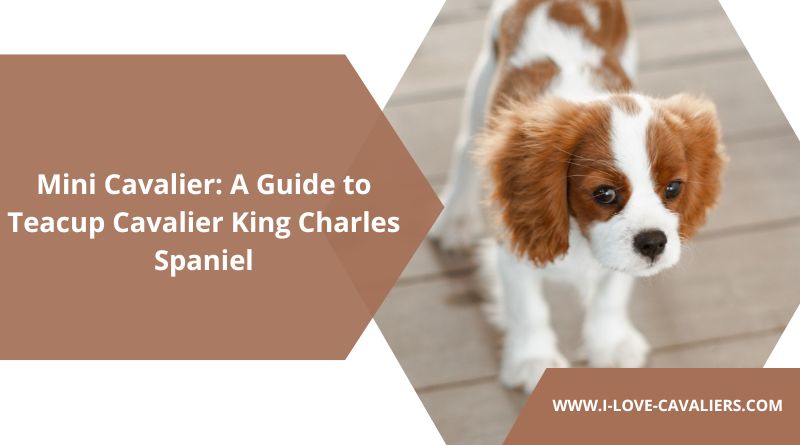Is there really a miniature Cavalier King Charles Spaniel, or is it merely a legend? The truth is that this little canine does exist, known as the teacup Cavalier King Charles Spaniel, which is an even more adorable, tiny variant of this already popular toy breed.
So, in today’s guide, I’m going to cover everything about teacup versions of Cavalier King Charles Spaniels, from their history, size, and the way they are produced, to their price and interesting facts.
Where Do Teacup Cavalier King Charles Spaniels Come From?
Let’s kick things off with a fundamental question – what is a teacup Cavalier King Charles Spaniel, and where does it originate from?
The teacup Cavalier King Charles Spaniels comes from the ‘original’ Cavalier King Charles Spaniels, a breed whose rich history traces back to the 17th century in England. Named after King Charles II, these Spaniels were bred to be companion dogs, admired for their affectionate nature, friendly disposition, and regal appearance.
Over centuries, Cavaliers have become quite popular (the 14th most popular dogs in 2022 in America), which eventually led to further breed diversification. And about when these mini King Charles Cavaliers came into the picture, no one’s exactly sure. But it is generally believed that the trend for teacups emerged in the early 21st century.
Even though American Kennel Club (AKC) does not formally recognize the teacup variety as an official breed, these miniaturized versions of Cavalier King Charles Spaniels have gained significant popularity due to their compact size and overall cuteness.
The petite form of King Charles Cavalier results from one of three distinct breeding techniques.
Breeding From Runts
The smallest and weakest pup in the litter, known as the runt, represents the only natural (which is also accidental) occurrence of a mini Cavalier King Charles Spaniel. However, some breeders (read unethical) deliberately choose these runt dogs for breeding, intending to develop a line of smaller-sized animals.
This breeding method raises several congenital problems, the most common being immune system difficulties and heart problems. In addition, when used for breeding, these health issues could potentially be passed on to their offspring.
So, if you’re seriously thinking about bringing home a little teacup Cavalier King Charles Spaniel, you should steer clear of any pups that come from runt inbreeding.
Dwarfism Gene
Another technique of breeding a miniature Cavalier King Charles Spaniel involves introducing a dwarfism gene into the breed. Dogs with dwarfism have shorter limbs in relation to their body size, resulting in a smaller stature.
Although this method can effectively produce petit dogs, it’s linked with many health problems, including skeletal issues, hair loss, heart issues, low blood sugar, limb deformities, underdeveloped muscles, and many other anomalies.
Consequently, introducing the dwarfism gene is often the least favored and least used method due to the associated health risks.
Crossbreeding With a Smaller Breed
Another way to produce the teacup puppy involves mixing the Cavalier King Charles Spaniel with a smaller breed. The aim is for the offspring to inherit the desirable traits from both parent breeds, including the smaller size of the other breed.
Keep in mind that this method is not always predictable, and the ‘teacup’ size isn’t always guaranteed.
A few popular mixes include:
- Miniature Cavapoo – A mix between a King Charles Cavalier and a Miniature Poodle
- Chilier – A mix between a King Charles Cavalier and a Chihuahua
- Miniature Cavamo – A mix between a King Charles Cavalier and a Miniature American Eskimo
These blends can result in smaller dogs, but each combination comes with its own set of potential health risks inherited from the parent breeds. Furthermore, the mixed breed puppies may possess different physical traits that deviate from the purebred Cavalier King Charles Spaniel standard, so they often don’t fit the description of an ‘original Cavalier teacup’.
At the end of the day, all three methods carry potential health risks, and if you’re seriously considering adopting a miniature Cavalier King Charles Spaniel, you should be absolutely certain you’re dealing with a reputable breeder. Be sure to request the genetic history of the puppy’s parents as well as any tests conducted to minimize potential health problems.
What Does the Teacup King Charles Cavalier Look Like?
The teacup King Charles Cavalier closely resembles the ‘original’ Cavalier King Charles Spaniel but in a smaller package. As with their standard-sized counterparts, they possess an elegant and regal appearance that is instantly recognizable.
Key features include:
| Feature | Description |
| Coat | Long, silky, slightly wavy; lush and full despite smaller size |
| Face | Short muzzles, big round eyes; gentle, curious expression |
| Ears | Large, silky, non-curly featherings |
| Body | Short-coupled frame, curved ribs; not barrel-shaped |
| Color | Blenheim, Tricolor, Black and Tan, Ruby |
- Blenheim

This pattern combines rich chestnut markings on a pearly white background. The distribution is ideally symmetric, creating a warm, vibrant contrast that enhances the breed’s overall elegance. A unique feature of the Blenheim is the “Blenheim Spot” or “Kissing Spot,” a chestnut spot at the top of the head.
- Tricolor

The Tricolor King Charles Spaniel showcases black and white markings with tan points, often on the cheeks, between the eyes, on the paws, and on the underside of the tail. The black portions provide a stark contrast to the white, while the tan accents bring a warm touch, resulting in a tri-toned coat
- Black and Tan

This color features a primarily black coat with tan markings, generally appearing over the eyes, on the cheeks, inside the ears, on the chest, paws, legs, and underside of the tail.
- Ruby

Ruby King Charles Spaniels are covered in a solid, deep, rich red color all over. This monochromatic appearance allows their coat’s natural silkiness and shine to stand out
How Big Do Teacup Cavalier King Charles Spaniels Get?
Now comes the most adorable part – teacup King Charles Cavalier size.
Full-grown teacup Cavalier King Charles Spaniels typically weigh no more than 10 pounds (4.5 kg) and are no taller than 10 inches (25.4 cm). In comparison, the standard-sized Cavalier King Charles Spaniel weighs between 12 and 18 pounds (5.4 – 8.2 kg) with an average height of 12 to 13 inches (30 – 33 cm).
The size mentioned refers to the ‘original teacup’ Cavvy, whereas other crossbreeds come in different sizes.
Miniature Cavapoos – the weight of a fully-grown Cavapoo may range from 9 to 25 pounds (4 to 11.3 kg), with a stature standing between 9 and 16 inches (23 to 40.6 cm) in height. Hence, there is a chance that the mix won’t be considered ‘teacup’ size.
Chiliers – usually weigh between 6 and 10 pounds (2.7 and 4.5 kg) and stand at a height of 8 to 10 inches (20.3 to 25.4 cm). So, they are highly likely to fall into the category of ‘teacup’ size dogs.
Miniature Cavamos – with a typical height of 9 to 12 inches (23 to 30.5 cm) and a weight range of 10 to 18 pounds (4.5 to 8.2 kg), mini Cavamos can potentially be smaller than their original Cavalier counterparts, achieving the “teacup” size.
Teacup Cavalier King Charles Spaniel Price
The price of a teacup Cavalier King Charles Spaniel can vary significantly based on several factors, such as the breeder’s reputation, location, and supply and demand at the time of purchase, among other factors.
Generally speaking, Cavalier King Charles Spaniels are expensive, so you can expect to pay for a mini version anywhere between $1,800 and $5,000, sometimes even higher than that. However, keep in mind that a price significantly lower than this may be suspicious, and you should investigate that breeder in detail, as well as the way the puppy has been bred.
Another thing to remember is that the purchase price is just part of the expenses of owning a pet. You should also consider the recurring monthly costs, such as regular vet checks, food, toys, insurance, grooming equipment, etc. All together, these can amount to an additional $80 to $200 a month.
Where Can You Find Teacup Cavalier King Charles Spaniel Puppies for Sale?
As mentioned, due to various potential health issues, you should avoid breeders promoting teacup variants for sale, as they are most likely bred unnaturally.
Nevertheless, if your preference leans towards a pint-sized pooch, an alternative method exists. Reach out to trustworthy and established Cavalier breeders in your area. Those who have a good reputation always put the health of their dogs first, and sometimes, they naturally get smaller-than-usual pups.
These puppies haven’t been put through risky breeding to make ‘teacup’ dogs, so they don’t have the same health concerns. Additionally, selecting a pup from a reputable source ensures you are benefiting from the breeder’s experience, advice, and post-purchase support.
But remember, even if you’re dealing with an ethical breeder, always ask for health certificates and proof of genetic screening to confirm that the puppy you’re bringing home comes from healthy parents and grandparents.
Related: How to Buy a King Charles Cavalier Without Health Problems
4 Facts About Cavalier King Charles Spaniel Mini
They Are Great For Apartment Living
Cavalier King Charles Spaniels, including the mini versions, are perfect for apartment living. They are super adaptable and can thrive in smaller spaces. Their friendly and sociable nature also makes them great for families with kids or other pets.
They Are Fragile
Sadly, due to their pocket size, teacup King Charles Cavaliers are much more fragile compared to their standard-sized counterparts. Their smaller size may make them more susceptible to injuries from accidental falls, even from small heights, particularly in their joints and bones.
They Have a Fast Metabolism
The metabolism of miniature Cavalier King Charles Spaniels is very rapid, leading to a higher caloric need relative to their size. This faster metabolism means that they require more frequent meals or snacks throughout the day to maintain their energy levels.
They Pee More Often
As is the case with any small dog, teacup Cavalier King Charles Spaniels require more frequent urination. This is due to their smaller bladders, which has a limited capacity.
Is the Teacup Cavalier King Charles Spaniel the Right Dog For You?
Teacup Cavalier King Charles Spaniels make wonderful pets for both individuals and families. Due to their petite size, they are easy to care for and are generally low maintenance.
However, as you’ve seen facts regarding the methods that are commonly used to produce these small-sized dogs, you should take that into consideration when weighing the pros and cons.
For example, the AKC strongly advises against buying teacup dogs of any breed due to the aforementioned potential issues. At the end of the day, the choice is entirely yours.
But to underscore once again, if you’re unable to obtain a teacup puppy from an ethical, well-respected, established breeder, then it might be best not to do so.
